Transcriptomic data exploration of consensus genes and molecular mechanisms between chronic obstructive pulmonary disease and lung adenocarcinoma
- PMID: 35918384
- PMCID: PMC9345949
- DOI: 10.1038/s41598-022-17552-x
Transcriptomic data exploration of consensus genes and molecular mechanisms between chronic obstructive pulmonary disease and lung adenocarcinoma
Abstract
Most current research has focused on chronic obstructive pulmonary disease (COPD) and lung adenocarcinoma (LUAD) alone; however, it is important to understand the complex mechanism of COPD progression to LUAD. This study is the first to explore the unique and jointly molecular mechanisms in the pathogenesis of COPD and LUAD across several datasets based on a variety of analysis methods. We used weighted correlation network analysis to search hub genes in two datasets from public databases: GSE10072 and GSE76925. We explored the unique and jointly molecular mechanistic signatures of the two diseases in pathogenesis through enrichment analysis, immune infiltration analysis, and therapeutic targets analysis. Finally, the results were confirmed using real-time quantitative reverse transcription PCR. Fifteen hub genes were identified: GPI, EZH2, EFNA4, CFB, ENO1, SH3PXD2B, SELL, CORIN, MAD2L1, CENPF, TOP2A, ASPM, IGFBP2, CDKN2A, and ELF3. For the first time, SELL, CORIN, GPI, and EFNA4 were found to play a role in the etiology of COPD and LUAD. The LUAD genes identified were primarily involved in the cell cycle and DNA replication processes; COPD genes we found were related to ubiquitin-mediated proteolysis, ribosome, and T/B-cell receptor signaling pathways. The tumor microenvironment of LUAD pathogenesis was influenced by CD4 + T cells, type 1 regulatory T cells, and T helper 1 cells. T follicular helper cells, natural killer T cells, and B cells all impact the immunological inflammation in COPD. The results of drug targets analysis suggest that cisplatin and tretinoin, as well as bortezomib and metformin may be potential targeted therapy for patients with COPD combined LUAD. These signatures may be provided a new direction for developing early interventions and treatments to improve the prognosis of COPD and LUAD.
© 2022. The Author(s).
Conflict of interest statement
The authors declare no competing interests.
Figures
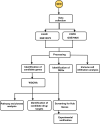
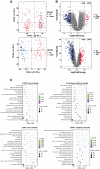

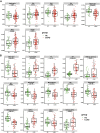
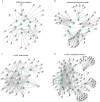
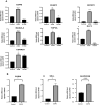
Similar articles
-
Identifying pyroptosis-related prognostic genes in the co-occurrence of lung adenocarcinoma and COPD via bioinformatics analysis.Sci Rep. 2025 Apr 30;15(1):15228. doi: 10.1038/s41598-025-97727-4. Sci Rep. 2025. PMID: 40307363 Free PMC article.
-
High Expression of UBB, RAC1, and ITGB1 Predicts Worse Prognosis among Nonsmoking Patients with Lung Adenocarcinoma through Bioinformatics Analysis.Biomed Res Int. 2020 Oct 20;2020:2071593. doi: 10.1155/2020/2071593. eCollection 2020. Biomed Res Int. 2020. PMID: 33134373 Free PMC article.
-
System analysis of FHIT in LUAD and LUSC: The expression, prognosis, gene regulation network, and regulation targets.Int J Biol Markers. 2022 Jun;37(2):158-169. doi: 10.1177/03936155221084056. Epub 2022 Mar 7. Int J Biol Markers. 2022. PMID: 35254116
-
Overexpression of CENPF is associated with progression and poor prognosis of lung adenocarcinoma.Int J Med Sci. 2021 Jan 1;18(2):494-504. doi: 10.7150/ijms.49041. eCollection 2021. Int J Med Sci. 2021. PMID: 33390818 Free PMC article.
-
Decoding LncRNA in COPD: Unveiling Prognostic and Diagnostic Power and Their Driving Role in Lung Cancer Progression.Int J Mol Sci. 2024 Aug 19;25(16):9001. doi: 10.3390/ijms25169001. Int J Mol Sci. 2024. PMID: 39201688 Free PMC article. Review.
Cited by
-
The neurological and non-neurological roles of the primary microcephaly-associated protein ASPM.Front Neurosci. 2023 Aug 3;17:1242448. doi: 10.3389/fnins.2023.1242448. eCollection 2023. Front Neurosci. 2023. PMID: 37599996 Free PMC article. Review.
-
Prediction of postoperative pulmonary complications in older patients undergoing lobectomy for lung cancer based on skeletal muscle mass.J Thorac Dis. 2023 Mar 31;15(3):1063-1074. doi: 10.21037/jtd-22-1156. Epub 2023 Mar 6. J Thorac Dis. 2023. PMID: 37065571 Free PMC article.
-
A Peptide Encoded by lncRNA HOXB-AS3 Promotes Cigarette Smoke-Induced Inflammation in Bronchial Epithelial Cells via EZH2-Mediated H3K27me3 Modification.Int J Chron Obstruct Pulmon Dis. 2025 May 20;20:1543-1553. doi: 10.2147/COPD.S495581. eCollection 2025. Int J Chron Obstruct Pulmon Dis. 2025. PMID: 40417409 Free PMC article.
-
Multi-modal transcriptomic analysis reveals metabolic dysregulation and immune responses in chronic obstructive pulmonary disease.Sci Rep. 2024 Sep 30;14(1):22699. doi: 10.1038/s41598-024-71773-w. Sci Rep. 2024. PMID: 39349929 Free PMC article.
-
AURKA, TOP2A and MELK are the key genes identified by WGCNA for the pathogenesis of lung adenocarcinoma.Oncol Lett. 2023 Apr 19;25(6):238. doi: 10.3892/ol.2023.13824. eCollection 2023 Jun. Oncol Lett. 2023. PMID: 37153047 Free PMC article.
References
MeSH terms
Substances
LinkOut - more resources
Full Text Sources
Medical
Research Materials
Miscellaneous

